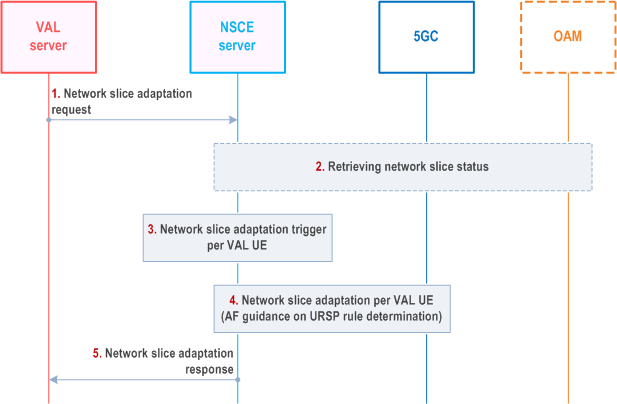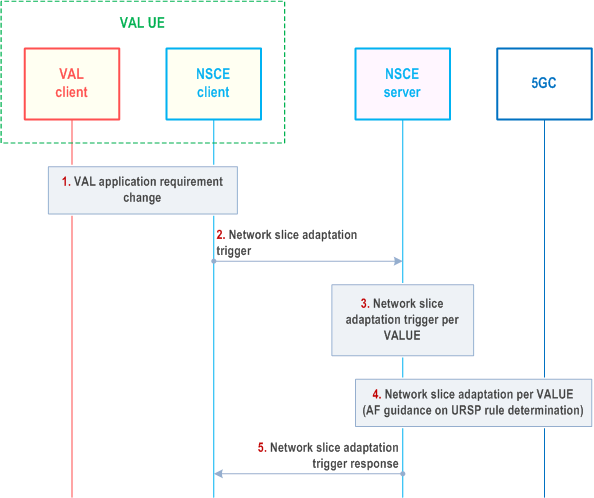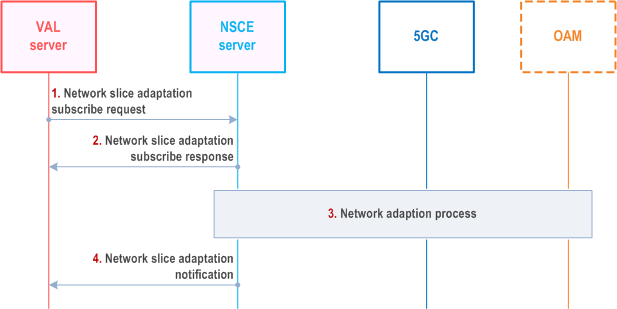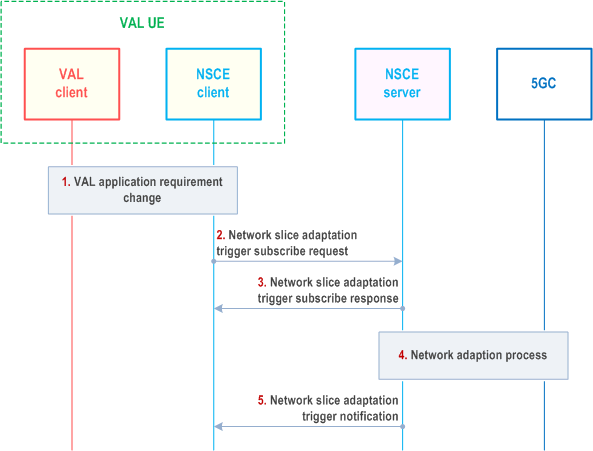Content for TS 23.435 Word version: 19.3.0
0…
4…
5…
7…
9…
9.4…
9.5…
9.6…
9.7…
9.8…
9.9…
9.10…
9.11…
9.12…
9.13…
9.14…
9.15…
9.16…
9.17…
9.18…
A…
9.11 Network slice adaptation for VAL application
9.11.1 General
9.11.2 Procedures
9.11.2.1 Procedure for VAL server-triggered and network-based network slice adaptation for VAL application - request and response model
9.11.2.2 Procedure for VAL UE-triggered and network-based network slice adaptation for VAL application - request and response model
9.11.2.3 Procedure for VAL server-triggered and network-based network slice adaptation for VAL application - subscribe and notify model
9.11.2.4 Procedure for VAL UE-triggered and network-based network slice adaptation for VAL application - subscribe and notify model
9.11.3 Information flows
9.11.4 APIs
9.11.4.1 General
9.11.4.2 SS_NSCE_NetworkSliceAdaptation API
...
...
9.11 Network slice adaptation for VAL application p. 76
9.11.1 General p. 76
This subclause describes the procedure for network slice adaptation at the Network Slice Capability Enablement (NSCE) server, based on a request from a VAL server to adapt the network slice for the VAL application. This request is handled between the NSCE server and the NSCE client per each VAL UE of the VAL application. Such adaptation assumes that the UE is subscribed to more than one slice and is done via providing a guidance to update the URSP rules at the 5GS (denoted in clause 9.11.2.1 as network-based mechanism).
9.11.2 Procedures p. 76
9.11.2.1 Procedure for VAL server-triggered and network-based network slice adaptation for VAL application - request and response model p. 76
Figure 9.11.2.1-1 illustrates the VAL server-triggered and network-based procedure where the NSCE server supports the network slice adaptation with the underlying 3GPP system for the VAL UEs of the VAL application.

Step 1.
The VAL server sends a network slice adaptation request to the NSCE server for the VAL application (and the VAL UEs within the VAL application). This request may be in the form of exact requested network slice (and optionally DNN) for all the VAL UEs of the VAL application; or indication that the VAL application needs to be remapped to a different network slice (and optionally DNN). The request optionally includes the adaptation threshold of network slice adaptation as defined in Table 9.11.3.1-1.
Step 2.
[Optional] NSCE server collects the network slice status information, including network slice performance measurements in clause 5.1.1.1, clause 5.1.1.2, clause 5.1.1.3, in TS 28.552 and key performance indicators in clause 6.3 of TS 28.554, and network slice related E2E latency analytics report in clause 8.4.2.4.3 of TS 28.104 from network slice management functions by utilizing MnS of create MOI operation defined in clause 11.1 and MnS of streaming data reporting service or file data reporting service defined in clause 11.5 and 11.6, TS 28.532.
Step 3.
The NSCE server processes the request and triggers the network slice configuration per VAL UE within the VAL Application. If network slice status from step 2 is considered, the NSCE server analyses the network slice status information before triggering the network slice configuration. If the threshold is crossed for the current network slice of adaptation and the objective network slice satisfy the requests, NSCE server triggers the network slice configuration per VAL UE within the VAL Application.
Step 4.
The NSCE server acting as AF provides the updated S-NSSAI and DNN per VAL UE. In particular, NSCE server sends this information to the PCF via NEF as part of the AF-driven guidance for URSP determination to 5G system (as specified in clause 4.15.6.10 of TS 23.502, clause 6.6.2.2 of TS 23.503, clause 6.2.4 of TS 23.548). This guidance may update the route selection parameters to indicate different sets of PDU Session information (DNN, S-NSSAI) that can be associated with applications matching the application traffic.
Step 5.
Upon successful adaptation of the route selection parameters, the NSCE server provides a network slice adaptation response to the VAL server, providing information on the fulfilment of the network slice adaptation request per VAL application.
9.11.2.2 Procedure for VAL UE-triggered and network-based network slice adaptation for VAL application - request and response model p. 77
Figure 9.11.2.2-1 illustrates the VAL UE-triggered and network-based procedure where the NSCE server supports the network slice adaptation with the underlying 3GPP system for the VAL UEs of the VAL application.
Pre-condition:
- The NSCE client has connected to the NSCE server;

Step 1.
The VAL client provides a new application requirement to the NSCE client, indicating a new service profile for the VAL application. This may be in the form of a change at the application QoS requirements, location requirements, time window requirement, access type preference (e.g., 3GPP, non-3GPP or multi access) service operation change, or other application-related parameters.
Step 2.
The NSCE client sends a network slice adaptation trigger to the NSCE server for the VAL application. This trigger may be in the form of exact requested network slice (and optionally DNN) for the VAL UE of the VAL application; or indication that the VAL application needs to be remapped to a different network slice (and optionally DNN). The trigger may also include additional application requirements based on step1, e.g., the requested location criteria, time window.
Step 3.
The NSCE server processes the request and triggers the network slice configuration per VAL UE within the VAL Application.
Step 4.
The NSCE server acting as AF provides the updated S-NSSAI, application requirements and DNN per VAL UE. In particular, NSCE server sends this information to the PCF via NEF as part of the AF-driven guidance for URSP determination to 5G system (as specified in clause 4.15.6.10 of TS 23.502, clause 6.6.2.2 of TS 23.503, clause 6.2.4 of TS 23.548). This guidance may update the route selection parameters to indicate different sets of PDU Session information (DNN, S-NSSAI, application requirements) that can be associated with applications matching the application traffic. 5GC uses this information to update the URSP to the affected UE(s).
Step 5.
The NSCE server sends the response to the NSCE client indicating success or failure.
9.11.2.3 Procedure for VAL server-triggered and network-based network slice adaptation for VAL application - subscribe and notify model p. 78
Figure 9.11.2.3-1 illustrates the VAL server-triggered and network-based procedure with subscribe and notify model where the NSCE server supports the network slice adaptation with the underlying 3GPP system for the VAL UEs of the VAL application.

Step 1.
The VAL server sends a network slice adaptation subscribe request to the NSCE server for the VAL application (and the VAL UEs within the VAL application). This request may be in the form of exact requested network slice (and optionally DNN) for all the VAL UEs of the VAL application; or indication that the VAL application needs to be remapped to a different network slice (and optionally DNN). The request optionally includes the adaptation threshold of network slice adaptation as defined in Table 9.11.3.1-1.
Step 2.
The NSCE server confirms the subscription and returns the network slice adaptation subscribe response.
Step 3.
The NSCE server may interact with the 5GC and OAM to collects the network slice status and performs the network slice adaptation per VAL UE as described in step 2- step 4 in clause 9.11.2.1.
Step 4.
When the network slice adaptation completes, and the adaption result comes out and available, the NSCE server provides the network slice adaptation notification to the VAL server.
9.11.2.4 Procedure for VAL UE-triggered and network-based network slice adaptation for VAL application - subscribe and notify model p. 79
Figure 9.11.2.4-1 illustrates the VAL UE-triggered and network-based procedure with subscribe and notify modeld where the NSCE server supports the network slice adaptation with the underlying 3GPP system for the VAL UEs of the VAL application.
Pre-condition:
- The NSCE client has connected to the NSCE server;

Step 1.
The VAL client provides a new application requirement to the NSCE client, indicating a new service profile for the VAL application. This may be in the form of a change at the application QoS requirements, location requirements, time window requirement, access type preference (e.g., 3GPP, non-3GPP or multi access) service operation change, or other application-related parameters.
Step 2.
The NSCE client sends a network slice adaptation trigger subscribe request to the NSCE server for the VAL application. This trigger may be in the form of exact requested network slice (and optionally DNN) for the VAL UE of the VAL application; or indication that the VAL application needs to be remapped to a different network slice (and optionally DNN). The trigger may also include additional application requirements based on step1, e.g., the requested location criteria, time window.
Step 3.
The NSCE server confirms the subscription and responds with a network slice adaptation trigger subscribe response.
Step 4.
The NSCE server performs the network slice adaptation per VAL UE as described in step 3- step 4 in clause 9.11.2.2.
Step 5.
When the network slice adaptation completes, and the adaption result comes out and available, the NSCE server provides the network slice adaptation notification to the NSCE client.
9.11.3 Information flows p. 80
9.11.3.1 Network slice adaptation request p. 80
Table 9.11.3.1-1 describes the information flow network slice adaptation request from the VAL server to the NSCE server.
| Information element | Status | Description |
|---|---|---|
| VAL service ID | M | The VAL service ID of the VAL application for which the network slice adaptation may corresponds to. |
| List of VAL UE IDs | M | List of the VAL UE IDs within the VAL service for which the slice adaptation request corresponds. |
| Requested Network slice related identifier(s) | O | Identifier of network slice for which the VAL server requests to use for adaptation. |
| Requested monitored Network slice related identifier(s) | O
(see NOTE 1) | Identifier of the provisioned network slice(s) which are provisioned for the listed UE(s) and requested to be monitored by NSCE server. |
| Requested DNN | O | Indication of the new DNN which is requested. |
| Requested Adaptation threshold | O
(see NOTE 2) | The threshold of network slice adaptation. |
| > Requested adaptation threshold of the delay of network slice | O | The network slice delay defined clause 5.1.1.1, 5.1.1.2, 5.1.1.3, in TS 28.552 and key performance indicators in clause 6.3 of TS 28.554, and network slice related analytics report in clause 8.4.2.4.3 of TS 28.104. |
|
NOTE 1:
If this IE is not present then the NSCE server monitors all the slices provisioned for the listed UE(s) mentioned in this request. If this IE is present, the NSCE server monitors the network slice(s) only indicated by the identifier(s).
NOTE 1:
The NSCE is requested to adapt UE to the requested network slice only when the status of the provisioned network slice for the listed UE(s) crosses the requested threshold.
|
||
9.11.3.2 Network slice adaptation response p. 80
Table 9.11.3.2-1 describes the information flow network slice adaptation response from the NSCE server to the VAL server.
| Information element | Status | Description |
|---|---|---|
| Result | M | Result includes success or failure of the network slice adaptation with the underlying network. |
| Cause | O | Indicates the cause of failure. |
9.11.3.3 Network slice adaptation trigger p. 80
Table 9.11.3.3-1 describes the information flow Network slice adaptation trigger from the NSCE client to the NSCE server.
| Information element | Status | Description |
|---|---|---|
| VAL UE ID(s) | M | The VAL UE ID(s) within the VAL service, for which the network slice adaptation trigger applies. |
| VAL service ID | M | The VAL service ID of the VAL application for which the network slice configuration may corresponds to. |
| Requested S-NSSAI | M | Indication of the new S-NSSAI which is requested. |
| Requested DNN | O | Indication of the new DNN which is requested. |
| Request application requirements | O | The application-related request parameters. |
| > Requested time window | O | Indication of the new scheduled time window that is requested. |
| > Requested location criteria | O | Indication of the new location criteria that is requested. |
| > Requested access type preference | O | Indication of the new access type (3GPP, non-3GPP or multi-access) preference that is requested. |
9.11.3.4 Network slice adaptation trigger response p. 81
Table 9.11.3.4-1 describes the information flow network slice adaptation trigger response from the NSCE server to the NSCE client and optionally to the VAL client.
| Information element | Status | Description |
|---|---|---|
| Result | M | Result includes success or failure of the network slice adaptation. |
| Cause | O | Indicates the cause of failure. |
9.11.3.5 Network slice adaptation subscribe request p. 81
Table 9.11.3.5-1 describes the information flow network slice adaptation subscribe request from the VAL server to the NSCE server.
| Information element | Status | Description |
|---|---|---|
| VAL service ID | M | The VAL service ID of the VAL application for which the network slice adaptation may corresponds to. |
| List of VAL UE IDs | M | List of the VAL UE IDs within the VAL service for which the slice adaptation request corresponds. |
| Requested Network slice related identifier(s) | O | Identifier of network slice for which the VAL server requests to use for adaptation. |
| Requested monitored Network slice related identifier(s) | O
(see NOTE 1) | Identifier of the provisioned network slice(s) which are provisioned for the listed UE(s) and requested to be monitored by NSCE server. |
| Requested DNN | O | Indication of the new DNN which is requested. |
| Requested Adaptation threshold | O
(see NOTE 2) | The threshold of network slice adaptation. |
| > Requested adaptation threshold of the delay of network slice | O | The network slice delay defined clause 5.1.1.1, 5.1.1.2, 5.1.1.3, in TS 28.552 and key performance indicators in clause 6.3 of TS 28.554, and network slice related analytics report in clause 8.4.2.4.3 of TS 28.104. |
|
NOTE 1:
If this IE is not present then the NSCE server monitors all the slices provisioned for the listed UE(s) mentioned in this request. If this IE is present, the NSCE server monitors the network slice(s) only indicated by the identifier(s).
NOTE 2:
The NSCE is requested to adapt UE to the requested network slice only when the status of the provisioned network slice for the listed UE(s) crosses the requested threshold.
|
||
9.11.3.6 Network slice adaptation subscribe response p. 82
Table 9.11.3.6-1 describes the information flow network slice adaptation subscribe response from the NSCE server to the VAL server.
| Information element | Status | Description |
|---|---|---|
| Subscription ID | M
(see NOTE) | Identifier of the subscription. |
| Result | M | Result includes success or failure of subscription. |
| Cause | O | Indicates the cause of failure. |
|
NOTE:
Only present if the result is success.
|
||
9.11.3.7 Network slice adaptation trigger subscribe request p. 82
Table 9.11.3.7-1 describes the information flow Network slice adaptation trigger subscribe request from the NSCE client to the NSCE server.
| Information element | Status | Description |
|---|---|---|
| VAL UE ID(s) | M | The VAL UE ID(s) within the VAL service, for which the network slice adaptation trigger applies. |
| VAL service ID | M | The VAL service ID of the VAL application for which the network slice configuration may corresponds to. |
| Requested S-NSSAI | M | Indication of the new S-NSSAI which is requested. |
| Requested DNN | O | Indication of the new DNN which is requested. |
| Request application requirements | O | The application-related request parameters. |
| > Requested time window | O | Indication of the new scheduled time window that is requested. |
| > Requested location criteria | O | Indication of the new location criteria that is requested. |
| > Requested access type reference | O | Indication of the new access type (3GPP, non-3GPP or multi-access) preference that is requested. |
9.11.3.8 Network slice adaptation trigger subscribe response p. 83
Table 9.11.3.8-1 describes the information flow network slice adaptation trigger subscribe response from the NSCE server to the NSCE client and optionally to the VAL client.
| Information element | Status | Description |
|---|---|---|
| Subscription ID | M
(see NOTE) | Identifier of the subscription. |
| Result | M | Result includes success or failure of subscription. |
| Cause | O | Indicates the cause of failure. |
|
NOTE:
Only present if the result is success.
|
||
9.11.3.9 Network slice adaptation notification p. 83
Table 9.11.3.9-1 describes the information flow network slice adaptation notification from the NSCE server to the VAL server or to the NSCE client.
| Information element | Status | Description |
|---|---|---|
| Subscription ID | M (NOTE) | Identifier of the subscription. |
| Adaption result | M | Result includes success or failure of the network slice adaptation with the underlying network. |
| Cause | O | Indicates the cause of failure. |
9.11.4 APIs p. 83
9.11.4.1 General p. 83
Table 9.11.4.1-1 illustrates the APIs for VAL server-triggered and network-based network slice adaptation.
| API Name | API Operations | Known Consumer(s) | Communication Type |
|---|---|---|---|
| SS_ | Network_slice_adaptation | VAL server | Request /Response |
Table 9.11.4.1-2 illustrates the APIs for VAL UE-triggered and network-based network slice adaptation
| API Name | API Operations | Known Consumer(s) | Communication Type |
|---|---|---|---|
| SS_ | Network_slice_adaptation_trigger | VAL server | Request /Response |
9.11.4.2 SS_NSCE_NetworkSliceAdaptation API p. 84
9.11.4.2.1 General p. 84
API description: This API enables the VAL server to communicate with the network slice capability enablement server for network slice adaptation over NSCE-S.
9.11.4.2.2 Network_Slice_Adaptation p. 84
API operation name:
Network_Slice_Adaptation
Description:
Requesting for network slice adaptation.
Known Consumers:
VAL server.
Inputs:
Outputs:
See subclause 9.11.2.1 for the details of usage of this API operation.